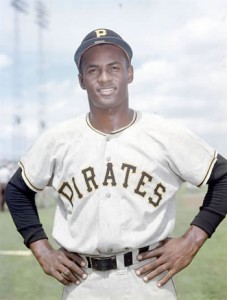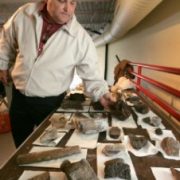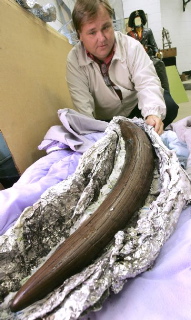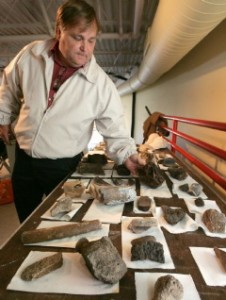Smithsonian Affiliates across the country are bringing Smithsonian Institution Traveling Exhibition Service (SITES) exhibitions to their communities this winter. Here’s what’s opening at an Affiliate near you:

In 1954, Clemente signed with the Pittsburgh Pirates. “I didn’t even know where Pittsburgh was,” Clemente later admitted. This image was taken on the field in 1957. AP/Wide World Photo
November 5, 2011 – January 1, 2012
Reginald F. Lewis Museum of Maryland African American History and Culture(Baltimore, Maryland)
Beyond Baseball: The Life of Roberto Clemente
The baseball diamond has produced legendary athletes who have broken records and shattered barriers. But for many, Roberto Clemente is the most inspiring of all. With a cannon arm and lightning speed, he was an outstanding ballplayer. But the Puerto Rico native was also a dedicated humanitarian.
Special programming in conjunction with the exhibition
- On Sundays throughout the month of November, visitors to the museum can participate in SUNDAYS @ 2 FILMS series. Featured films are: Béisbol: The Latin Game, Third World California, From Mambo to Hip Hop: A South Bronx Tale, and Yo soy Boricua, pa’que tu lo sepas! (“I’m Puerto Rican, Just So You Know!”).
- Raise Your Brown Black Fist: The Political Shouts of an Angry Afro-Latino (Book Talk) (Saturday, December 10, 2 p.m.) Through political commentary, author, screenwriter, activist and journalist Kevin Alberto Sabio addresses the unspoken African heritage of Latino culture, the exclusion of Afro-Latinos from mainstream American and Latino society and the hidden history of unity between the two.

Radmilla Cody, Miss Navajo Nation, and her grandmother, 2006. Radmilla Cody became Miss Navajo in 1997. Although she proved her cultural knowledge, her selection was controversial in the Navajo community because she has mixed race heritage. © 2009 John Running
November 5, 2011 – January 1, 2012
Reginald F. Lewis Museum of Maryland African American History and Culture(Baltimore, Maryland)
IndiVisible: African-Native American Lives in the Americas
IndiVisible: African-Native American Lives in the Americas explores historical and contemporary stories of peoples and communities whose shared histories are woven into the fabric of American identity but whose presence has long been invisible to many in the United States.
Special programming in conjunction with the exhibition:
- Painted Gourd: Red and Black Voices (Saturday, November 5, 3 p.m.) Penny Gamble Williams, a descendant from the Chappaquiddick Band of the Wampanoag Nation of Massachusetts, examines the intercultural relationships between Native American and African Americans.
- Genealogy Workshop: Researching Black Indian Ancestry East of the Mississippi (Saturday, November 19, 10:30 a.m.)Join author and blogger Angela Walton-Raji for a presentation on research methods of documenting African American and Native American family history.
- Native American Dance Presentation (Cultural Program) (Saturday, November 26, 2 p.m.) Native American dancers with the Baltimore American Indian Center perform social dances that explain their history.
- SUNDAYS @ 2 FILMS: Black Indians: An American Story (Sunday, December 4, 2 p.m.)

Filipino and other Asian immigrants were recruited as early as the mid-1800s to accommodate the agricultural demands of the West Coast and Hawai’i. Courtesy Center for Labor Education and Research, University of Hawai’i at West O’ahu
November 12, 2011 – January 22, 2012
Sonoma County Museum(Santa Rosa, California)
Singgalot: (The Ties That Bind) Filipinos in America, from Colonial Subjects to Citizens
Today there are more than 2.5 million Filipino Americans in the U.S. Yet many, including Filipinos themselves, aren’t familiar with the details of their history in America: their experiences, rich traditions, and culture. Singgalot is their story.
Special programming in conjunction with the exhibition:
- Film Screening: Remembering Our Manongs: Sonoma County’s Filipino History (Fri Dec 9, 2011 6:00pm – 8:00pm) A moving film documenting the Filipino presence in Sonoma County, produced with the help of the Filipino American National Historical Society (FANHS).
- Filipino-themed Family Day(Sat Dec 10, 2011 11:00am – 2:00pm) Activities will include dance and martial arts demonstrations, traditional Filipino children’s games, face painting, hands-on musical instruments, and more.

Salute to Matkatamiba. Photo by Kate Thompson
December 3, 2011 – February 26, 2012
Littleton Museum
(Littleton, Colorado)
Lasting Light: 125 Years of Grand Canyon Photography
Covering nearly 125 years of photographic history, the exhibition includes images of early photographers dangling from cables to get the perfect shot, their cumbersome camera equipment balanced precariously on their shoulders. More modern images are bold and dramatic, revealing the canyon’s capricious weather, its flora and fauna, waterfalls and wading pools, and awesome cliffs and rock formations.

Untitled Still Life, Flowers, ca. 1936-1938. Oil on burlap. Courtesy Morgan State University and SITES.
December 24, 2011 – March 18, 2012
Mennello Museum of American Art (Orlando, Florida)
William H. Johnson: An American Modern
A virtuoso skilled in various media and techniques, William Henry Johnson (1901-1970) produced thousands of works over a career that spanned decades, continents, and genres. Now, on view in its entirety for the first time, a seminal collection covering key stages in Johnson’s career. This exhibition of 20 expressionist and vernacular landscapes, still life paintings, and portraits explores the intricate layers of Johnson’s diverse cultural perspective as an artist and self-described “primitive and cultured painter.”

Legendary New York Mets’ coach Yogi Berra shares his line-up with Clemente before a 1972 spring training game in St. Petersburg, Florida. AP/Wide World Photo
January 21 – March 18, 2012
Orange County Regional History Center (Orlando, Florida)
Beyond Baseball: The Life of Roberto Clemente
The baseball diamond has produced legendary athletes who have broken records and shattered barriers. But for many, Roberto Clemente is the most inspiring of all. With a cannon arm and lightning speed, he was an outstanding ballplayer. But the Puerto Rico native was also a dedicated humanitarian.
Special programming in conjunction with the exhibition:
- Steve Blass on Baseball: A Pirate’s Life (January 21, 2012 – 6:00pm – 9:00pm) Steve Blass, former teammate and close friend of Roberto Clemente, helps the History Center celebrate the opening of the exhibition with a showing of the rare 1975 film, Roberto Clemente: A Touch of Royalty, that chronicles the contributions of Clemente.
Find a Smithsonian Affiliate in your neighborhood here.
Find more Smithsonian traveling exhibitions and programs here.

 This event is part of Shout, a collaboration between the Smithsonian Institution, Microsoft Partners in Learning, and TakingITGlobal. More at www.shoutlearning.org.
This event is part of Shout, a collaboration between the Smithsonian Institution, Microsoft Partners in Learning, and TakingITGlobal. More at www.shoutlearning.org.
























